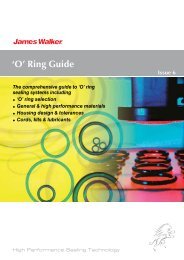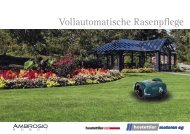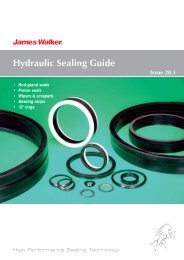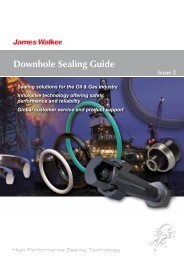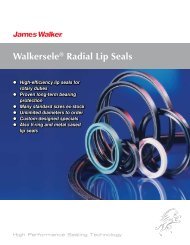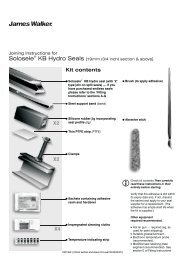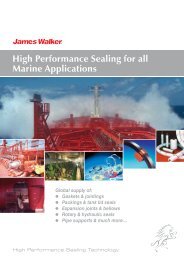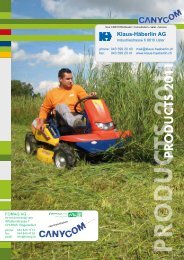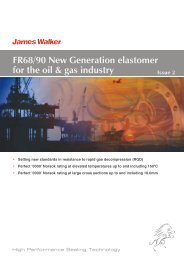Comflex® Rubber Expansion Joints Engineering Guide
Comflex® Rubber Expansion Joints Engineering Guide
Comflex® Rubber Expansion Joints Engineering Guide
You also want an ePaper? Increase the reach of your titles
YUMPU automatically turns print PDFs into web optimized ePapers that Google loves.
Installation and Maintenance<br />
for all Solid <strong>Rubber</strong> Flanges for Types 40, 42, 58, 59, 63<br />
Extract from documentation required by the Technical<br />
Inspectorate for type 40 large expansion joints (cooling<br />
water system in a nuclear power station).<br />
1. Identification<br />
1.1 Delivery documentation and expansion joint<br />
identification marking must correspond.<br />
1.2 Identification marking on the rubber expansion joint<br />
a) On the expansion joint collar, above<br />
the embossed name plate.<br />
XX<br />
XX/XX<br />
Production No. month/year<br />
b) Name plate James Walker Townson expansion<br />
joint made by Continental<br />
Type 40 xx/x<br />
xxx bar<br />
Material/inserts working operating pressure<br />
DN xxxx/xx<br />
Nominal width/flange<br />
build length xxx<br />
Standard build length*<br />
* Attention: The installation length (mounting) can<br />
vary! Check pre-restraint!<br />
3. Storage<br />
(see DIN 7716)<br />
“<strong>Guide</strong>lines for the storage of rubber parts”<br />
<strong>Rubber</strong> expansion joint must be stored stress-free without<br />
deformations and kinks. <strong>Rubber</strong> expansion joints must<br />
be stored upright on the flanges (to avoid the risk of<br />
crushing!).<br />
3.1 Storage room<br />
The storage room should be cool, dry and dustfree<br />
and moderately ventilated.<br />
3.2 Oxygen and ozone<br />
Protect rubber parts from draughts, cover in case<br />
of emergency. Do not operate ozone-producing<br />
devices such as electric motors, fluorescent light<br />
sources etc. in the store room.<br />
3.3 Co-storage<br />
Do not store with solvents, fuels, chemicals and<br />
similar items.<br />
2. Transport<br />
2.1 Packaging Package parts.<br />
Note “TOP” at the top and “cable or lifting hook”<br />
steel backing rings (with bracing) and the rubber<br />
expansion joint flanges must remain fastened until<br />
final mounting. The relatively light rubber part is<br />
bonded to heavy metal flanges - avoid excessive<br />
loading of the rubber part.<br />
2.2 Tools<br />
No sharp-edged tools, wire cables, chains or lifting<br />
hooks (danger of damage to rubber).<br />
2.3 Lifting and moving<br />
Always lift both steel flanges simultaneously.<br />
Shackle at both sides or place padded tie-bars<br />
through the expansion joint or lift both sides.<br />
2.4 Ground level transportation<br />
Move flanges by rolling.<br />
4. Installation<br />
4.1 Pipes<br />
4.1.1 Check dimensions of planned installation gaps.<br />
The total installation discrepancies in the piping<br />
and operating movements must not exceed the<br />
maximum movements specified in the design<br />
layout.<br />
4.1.2 Clean mating flanges, remove anti-corrosion paint<br />
from surfaces.<br />
4.1.3 Mating flanges must be smooth, flat and free from<br />
burrs.<br />
4.1.4 Do not subject the expansion joint to stress. Bolt<br />
holes must be in alignment.<br />
4.2 Bellows<br />
The bellows must not be painted or insulated.<br />
To order or get further details, call your local contact 57 shown on rear cover or listed at www.jameswalker.biz 57





